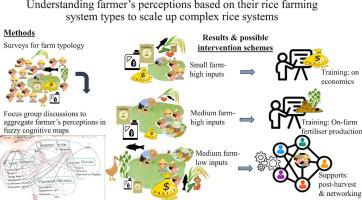当前位置:
X-MOL 学术
›
Agric. Syst.
›
论文详情
Our official English website, www.x-mol.net, welcomes your feedback! (Note: you will need to create a separate account there.)
Linking types of East Javanese rice farming systems to farmers' perceptions of complex rice systems
Agricultural Systems ( IF 6.1 ) Pub Date : 2024-05-22 , DOI: 10.1016/j.agsy.2024.104008 Uma Khumairoh , Heitor Mancini Teixiera , Sudhir Yadav , Rogier P.O. Schulte , Mary Ann Batas , Degi Harja Asmara , Rica Joy Flor , Rohmatin Agustina , Adi Setiawan , Euis E. Nurlaelih , Mangku Purnomo , Jeroen C.J. Groot
Agricultural Systems ( IF 6.1 ) Pub Date : 2024-05-22 , DOI: 10.1016/j.agsy.2024.104008 Uma Khumairoh , Heitor Mancini Teixiera , Sudhir Yadav , Rogier P.O. Schulte , Mary Ann Batas , Degi Harja Asmara , Rica Joy Flor , Rohmatin Agustina , Adi Setiawan , Euis E. Nurlaelih , Mangku Purnomo , Jeroen C.J. Groot

|
Complex rice systems (CRS) are polycultures in which rice is grown together with one or more plant or animal species using combined methods of practices from indigenous knowledge and modern science in augmenting ecological processes to foster ecosystem services in rice agroecosystems. However, their implementation faces challenges due to farmers' knowledge gaps, high capital outlay and labour shortages. This study aims to link types of rice farming and farmer perceptions to facilitate recommendations to scale up CRS. We constructed a farm typology based on a survey of 111 farm households and aggregated cognitive maps (ACMs) based on fuzzy cognitive maps developed in focus group discussions in Malang and Lamongan, East Java Province, Indonesia. The farm typology classified farm households into three types: (a) small farms with high inputs of agrochemicals (SH, = 29) which were all identified in Malang; (b) medium-size farms with high input intensity of agrochemicals (MH, = 43), distributed across Malang and Lamongan; and (c) medium-size farms with low inputs of agrochemicals (ML, = 39), all detected in Lamongan. ACMs revealed the differences in farmer group's perceptions on farm input-output relations, agroecosystems processes and CRS component interactions. SH and MH farmers prioritised economic benefits over ecosystem services and crop-livestock components. SH farmers were locked into high-input and high-output systems, while MH farmers failed to obtain high output despite high input use. Intervention schemes could be developed such as thorough training on economics for SH farmers and efficient use and on-farm production of fertilisers for MH farmers. Meanwhile, with the majority of ML farmers having adopted CRS, their priorities were more evenly distributed across all components, implying their more holistic understanding of the interacted components. However, technical assistance on agronomic, post-harvest management and marketing were still considered to be needed to ensure a long-term sustainability of CRS practices by ML farmers. Combining farm typology and fuzzy cognitive mapping could facilitate a comprehensive understanding of farming system types, their characteristics and farmer perceptions as a key to formulate appropriate interventions for a specific farm type. Therefore, these methodological approaches could provide guidance to accelerate transitions toward complex agroecosystems.
中文翻译:

将东爪哇水稻种植系统的类型与农民对复杂水稻系统的看法联系起来
复杂水稻系统(CRS)是一种混养,其中水稻与一种或多种植物或动物物种一起种植,利用本土知识和现代科学的综合实践方法来增强生态过程,以促进水稻农业生态系统中的生态系统服务。然而,由于农民知识差距、高资本支出和劳动力短缺,其实施面临挑战。本研究旨在将水稻种植类型和农民的看法联系起来,以促进提出扩大 CRS 的建议。我们根据对 111 个农户的调查构建了农场类型,并根据印度尼西亚东爪哇省玛琅和拉蒙安焦点小组讨论中开发的模糊认知图构建了聚合认知图 (ACM)。农场类型将农户分为三类:(a) 农用化学品投入高的小型农场 (SH, = 29),这些都在玛琅找到; (b) 农用化学品投入强度高的中型农场(MH,= 43),分布在玛琅和拉蒙干; (c) 农用化学品投入量低的中型农场 (ML, = 39),均在拉蒙岸发现。 ACM 揭示了农民群体对农业投入产出关系、农业生态系统过程和 CRS 组成部分相互作用的看法差异。 SH 和 MH 农民将经济效益置于生态系统服务和农作物-牲畜组成部分之上。 SH农民被锁定在高投入和高产出系统中,而MH农民尽管投入高,但未能获得高产出。可以制定干预计划,例如对 SH 农民进行全面的经济学培训以及对 MH 农民进行肥料的有效使用和农场生产。 与此同时,由于大多数 ML 农民都采用了 CRS,他们的优先事项在所有组成部分中分布得更加均匀,这意味着他们对相互作用的组成部分有更全面的了解。然而,仍认为需要农艺、收获后管理和营销方面的技术援助,以确保 ML 农民 CRS 实践的长期可持续性。将农场类型学和模糊认知图相结合可以促进对农业系统类型、其特征和农民认知的全面理解,作为针对特定农场类型制定适当干预措施的关键。因此,这些方法可以为加速向复杂农业生态系统的转型提供指导。
更新日期:2024-05-22
中文翻译:

将东爪哇水稻种植系统的类型与农民对复杂水稻系统的看法联系起来
复杂水稻系统(CRS)是一种混养,其中水稻与一种或多种植物或动物物种一起种植,利用本土知识和现代科学的综合实践方法来增强生态过程,以促进水稻农业生态系统中的生态系统服务。然而,由于农民知识差距、高资本支出和劳动力短缺,其实施面临挑战。本研究旨在将水稻种植类型和农民的看法联系起来,以促进提出扩大 CRS 的建议。我们根据对 111 个农户的调查构建了农场类型,并根据印度尼西亚东爪哇省玛琅和拉蒙安焦点小组讨论中开发的模糊认知图构建了聚合认知图 (ACM)。农场类型将农户分为三类:(a) 农用化学品投入高的小型农场 (SH, = 29),这些都在玛琅找到; (b) 农用化学品投入强度高的中型农场(MH,= 43),分布在玛琅和拉蒙干; (c) 农用化学品投入量低的中型农场 (ML, = 39),均在拉蒙岸发现。 ACM 揭示了农民群体对农业投入产出关系、农业生态系统过程和 CRS 组成部分相互作用的看法差异。 SH 和 MH 农民将经济效益置于生态系统服务和农作物-牲畜组成部分之上。 SH农民被锁定在高投入和高产出系统中,而MH农民尽管投入高,但未能获得高产出。可以制定干预计划,例如对 SH 农民进行全面的经济学培训以及对 MH 农民进行肥料的有效使用和农场生产。 与此同时,由于大多数 ML 农民都采用了 CRS,他们的优先事项在所有组成部分中分布得更加均匀,这意味着他们对相互作用的组成部分有更全面的了解。然而,仍认为需要农艺、收获后管理和营销方面的技术援助,以确保 ML 农民 CRS 实践的长期可持续性。将农场类型学和模糊认知图相结合可以促进对农业系统类型、其特征和农民认知的全面理解,作为针对特定农场类型制定适当干预措施的关键。因此,这些方法可以为加速向复杂农业生态系统的转型提供指导。











































 京公网安备 11010802027423号
京公网安备 11010802027423号